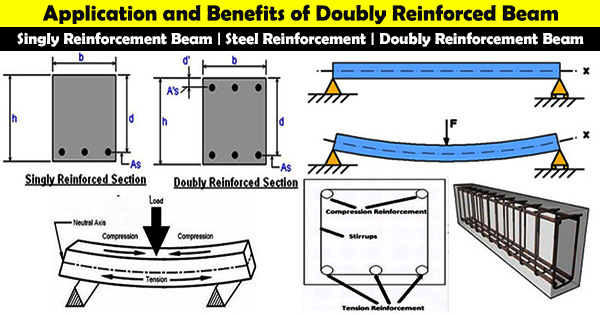Application and benefits of doubly reinforced beam

Concrete is strong against compression but it is weak in tension. Therefore, the steel reinforcement bars are arranged in the tension zone of the beam in order that the tensile stresses are consumed by the steel.
There are two types of zones in beam like compression zone and tension zone. Normally, reinforcement is arranged to tension zone and it is known as singly reinforced section.
While constructing heavy structure, heavy loads are generated from slab to beam and in order to accommodate this load, additional strength is required. So, the reinforcement is also arranged in compression zone and it is known as compression reinforcement.
When there are both tension reinforcement and compression reinforcement in beam, this arrangement is known as doubly reinforced section or doubly reinforced beam.
The doubly reinforcement is required in the following situations:-
If the size of beam (B x D) is restrained because of headroom clearance and architectural standpoint.
In beam, there may be simple supported conditions, continuous conditions, cantilever or other conditions and at this time specific bending moment is created in beam. The simply supported section can’t pacify this moment. To withstand this bending moment, it is necessary to provide doubly reinforced section.
The brittle fracture should not occur on the entire structure since it leads to sudden failure of the structure. When the single reinforced section is raised, an over reinforced section is formed and it leads to sudden failure of the structure as it never shows any crack. To get rid of this issue, doubly reinforced is required.
When the external load is alternating that signifies the load is operating on the face of the member.
The load is eccentric and the eccentricity of the load is transforming from one side to another side of the axis.
The member is exposed to a shock or impact or accidental lateral thrust.
To get more detail information, go through the following exclusive video tutorial.
Video Courtesy : Tutorials Tips

